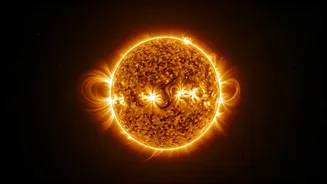Unveiling Solar Secrets
The primary objective of the Aditya-L1 mission is to conduct a detailed study of the Sun. This involves observing the solar corona, the outermost layer
of the Sun's atmosphere, as well as the chromosphere and photosphere, which are the deeper layers. The spacecraft's instruments are designed to analyze various solar phenomena like solar flares and coronal mass ejections (CMEs). Studying these events is critical, as they can significantly impact Earth, affecting satellites, communication systems, and power grids. The data gathered from Aditya-L1 will help in creating more precise models of space weather and understanding how solar activity influences our planet.
Mission's Scientific Payload
Aditya-L1 is equipped with seven scientific payloads to facilitate its comprehensive solar observations. These instruments will work in unison to provide a multi-faceted view of the Sun. Key payloads include a Visible Emission Line Coronagraph (VELC) to study the solar corona, a Solar Ultraviolet Imaging Telescope (SUIT) to observe the Sun in ultraviolet light, and an X-ray Spectrometer to examine solar flares. Additionally, the mission has detectors for measuring solar wind particles and magnetic fields. This diverse suite of instruments allows scientists to collect data across the electromagnetic spectrum and analyze the dynamics of the Sun and its impact on the space environment around Earth. This will improve understanding of the Sun's behavior and its influence on Earth.
Observing From L1
The spacecraft is positioned at the Lagrange point 1 (L1) of the Sun-Earth system, approximately 1.5 million kilometers away from Earth. This location is advantageous because it provides an uninterrupted view of the Sun, without the interference from eclipses or Earth's atmosphere. Being at L1 means Aditya-L1 can continuously monitor the Sun, allowing scientists to observe solar events in real-time. This continuous monitoring capability is crucial for tracking the evolution of solar flares and CMEs, and for understanding how these events propagate through space. This vantage point significantly enhances the mission's ability to observe and study the Sun.
Impacting Space Weather
A major goal of the Aditya-L1 mission is to improve space weather forecasting. Solar flares and CMEs can release significant amounts of energy and charged particles, which can disrupt Earth's magnetosphere and ionosphere. This can lead to problems like communication blackouts, GPS errors, and damage to satellites. By providing real-time data on these solar events, Aditya-L1 will contribute to early warnings and better predictions of space weather events. This enhanced forecasting capability is expected to help protect critical infrastructure and mitigate potential hazards associated with solar activity. The mission therefore plays a crucial role in safeguarding technology on Earth and in space.
Advancing Indian Space Science
The Aditya-L1 mission marks a significant advancement for India in the field of space science. It showcases India's capabilities in developing and deploying sophisticated space-based observatories. The data obtained from Aditya-L1 will be invaluable to scientists across the globe and will be available for open access. This mission not only enhances India's prestige in space exploration but also stimulates innovation and technological advancements within the country's space program. It contributes to India's broader vision of advancing scientific research and technological expertise, reinforcing its position as a key player in global space exploration endeavors.













